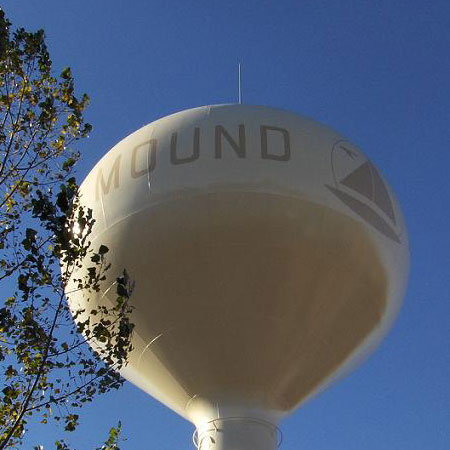Mound Water Softener and Drinking Water Guide

In November 2006, the City received notification from the Department of Health that the average annual level of Arsenic in Well #7 was 10.8 ppb which exceeded the MCL of 10.0 ppb. Since the City’s existing and future water demand needs can be adequately met by the recently upgraded Wells #3 and #8, Well #7 will now only be used as an emergency/ backup well.
Rust Stains from Mound Water
Iron is another natural metal in Mound water with concentrations ranging between 0.2-0.8ppm. In areas with over 0.3ppm, discolored laundry, stained fixtures, and a metallic taste or smell may be noticed.
- Soft Water
- National Hardness Average
- Mound Water Hardness
Mound, MN Water Softener Recommendations
The national average for water hardness is 5gpg (grains per gallon). Mound, MN water hardness is 22-28gpg, which is almost 6x harder than average.
A water softener will protect your water heater, plumbing, and appliances from hard water damage. A high efficiency water softener will offer the same protection, but will use far less water and salt.
Need the Right Water Softener or Filter for Your Home in Mound, MN?
Contact us for a FREE water test and site inspection. We’ll get you a FREE quote to help you get the water quality you want.
Mound MN Water Reports
The City of Mound, MN does regular water testing and publishes the results in Annual Drinking Water Reports. These reports explain which water contaminants, and what levels have been found.
MCL: Maximum Contaminant Level
The legal limit for a certain contaminant
MCLG: Maximum Contaminant Level GOAL
The level with ZERO HEALTH RISKS, aka the “Health Limit”
All water contaminants meet the EPA’s “Legal Limit”. Contaminants that exceed the EPA’s Health Limit have been highlighted below.
Inorganic Contaminants
Inorganic contaminants include natural and manmade salts and metals. You are mostly exposed to inorganics through drinking water, most do not easily pass through skin. Carbon Filters (refrigerator and faucet filters) have almost ZERO impact on these contaminants. Reverse Osmosis very effective at removing inorganic contaminants.
| Contaminant | Amount Found | Health Limit | Legal Limit | Potential Effects |
|---|---|---|---|---|
| Arsenic | 3.53-4.1 | 0 | 10 | Skin damage or problems w/ circulatory systems, increased risk of cancer |
| Barium | 0.016 | 2 | 2 | Increase in blood pressure |
| Fluoride | 0.87-1.2 | 4 | 4 | Bone disease;children may get mottled teeth |
| Iron | 0.2-0.8 | NA | 0.3 | Rusty, discolored water. Damage to plumbing and appliances |
Disinfectants and Disinfection Byproducts
Disinfectants are added to kill bacteria. Disinfectants like Chlorine react with other chemicals and create “Disinfection Byproducts. These chemicals enter the body through inhalation, absorption through skin, and drinking water. A Whole House Carbon Filter is a good preventative tool in addition to a Drinking Water System for these compounds.
| Contaminant | Amount Found | Health Limit | Legal Limit | Potential Effects |
|---|---|---|---|---|
| Chlorine | 0.5-2.2 | 4 | 4 | Eye/nose irritation; stomach discomfort |
| Chloroform | 0.46-1.3 | 5.7 | 80 | Nervous system depression, increase in kidney and liver tumors |
| Haloacetic Acids | 3.3 | 0 | 80 | Increased risk of cancer |
| Total Trihalomethanes | 0.52-1.6 | 0 | 60 | Increased risk of cancer |
Microbial Contaminants
Microbes like bacteria and virus come from a variety of sources. These include water main breaks, leaky septic systems, livestock, and wildlife. Microbial contaminants are mainly consumed through drinking water. Carbon Filters and Water Softeners do not offer any protection against microbes, but UV Treatment is very effective.
| Contaminant | Amount Found | Health Limit | Legal Limit | Potential Effects |
|---|---|---|---|---|
| Total Coliform Bacteria | 1% | 0 | 5 | Not a health threat itself; it is used to indicate whether other potentially harmful bacteria may be present |
*Upon re-testing, 0% Coliform Bacteria was detected.
Radionuclide Contaminants
Radionuclides in water may occur naturally, or come from oil and gas production or mining activities. These can be inhaled, or consumed through drinking water.
| Contaminant | Amount Found | Health Limit | Legal Limit | Potential Effects |
|---|---|---|---|---|
| Alpha Emitter | 2.77-7 | 0 | 15.4 | Increased risk of cancer |
| Combined Radium | 1.2 | 0 | 5 | Increased risk of cancer |
| Radon | 112-167 | 0 | NA | Increased risk of cancer |
